Wasps are narrow-waisted insects that are not an ant or a bee. They are known for their painful sting, along with their ability to sting more than once, unlike bees.
They live socially or solitary, depending on the species, and can be found in a range of habitats.
Continue reading to find out about the common wasps you may encounter in California, from the most popular to the least popular.
The 30 most common wasps you are likely to encounter in California include:
Table of Contents
1. California Gall Wasp
The California gall wasp (Andricus Quercuscalifornicus) is a small wasp that causes oak apple galls on white oak trees. This wasp can manipulate gall growth for their development.
Often several wasps at different life stages will occupy the small gall.
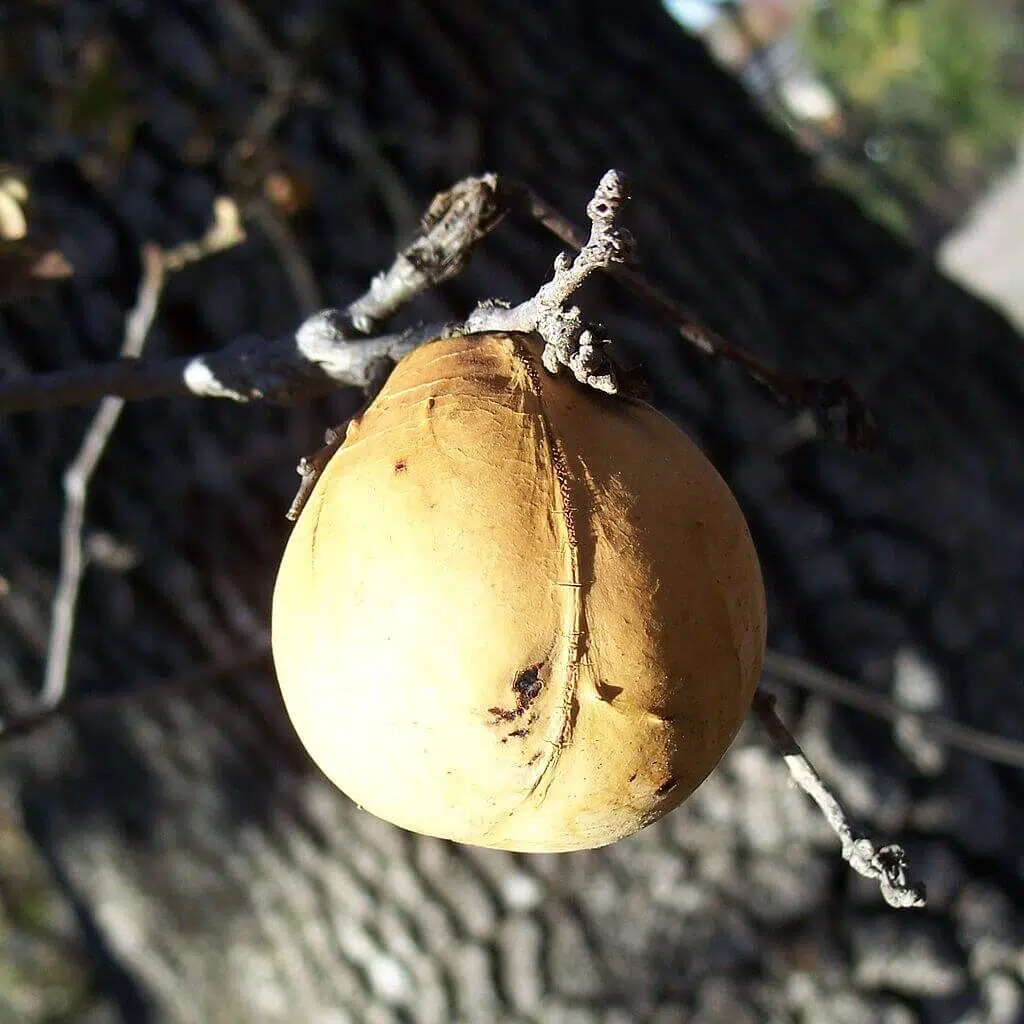
Adults are small and brown, growing to around 5mm in body length. Their wings are clear and double the length of the body. The galls on the oak are round and can vary from red to green, sometimes orange. Their sizes range from 2cm to 14m in diameter.
These wasps manipulate galls in a variety of oaks but are mostly found in the Valley Oak. The wasps are common in open foothill woodlands, valley savannas, suburban areas, riparian forests, and plant groves.
2. Western Yellowjacket
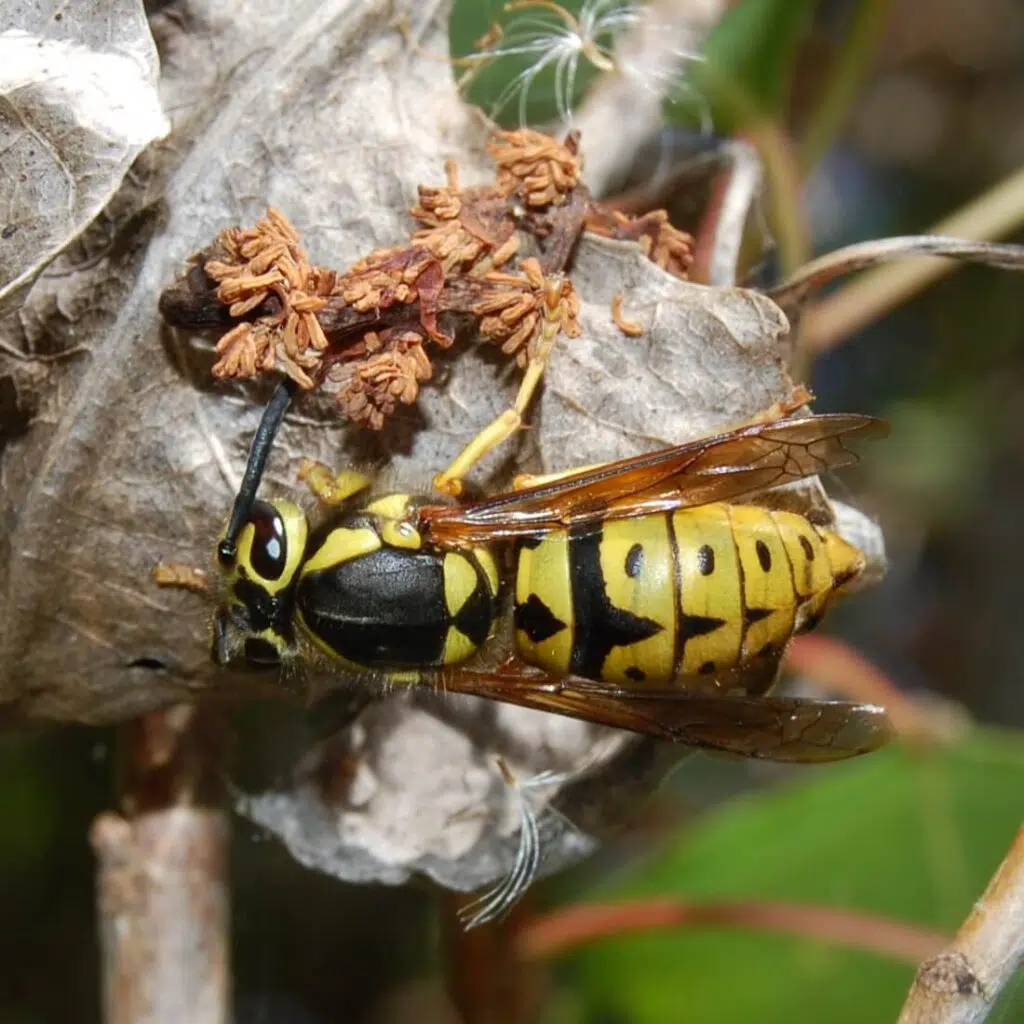
Western Yellowjackets (Vespula Pensylvanica) are one of the worst insects to encounter and are famous for their painful stings. They are attracted to sugars and will make themselves pests during outdoor gatherings. Females have stingers and they aggressively defend their nests.
The nests are usually built near or on the ground. These wasps have a yellow abdomen with a central black diamond shake with a black spot on each segment. Their legs are yellow.
Under no circumstances should you irritate or provoke one of these wasps, as they are not afraid to sting.
3. European Paper Wasp
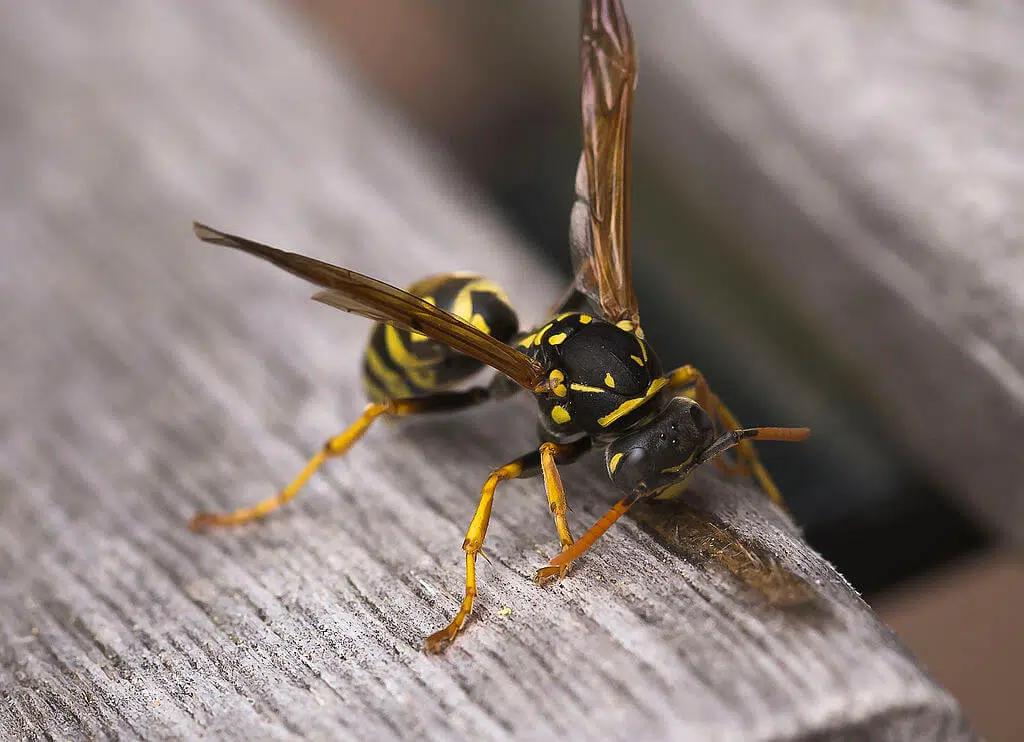
This is a very common wasp in California and is a social wasp with a diverse diet. There is very little size difference between males and females. They have yellow and black bodies with abdominal spots, which vary in size and location.
These wasps prefer terrestrial habitats and temperate climates. They are often encountered in grasslands, forests, and chaparrals. They have a habit of colonizing close to humans, using man-made structures for shelter.
4. Yellow-legged Mud-dauber Wasp
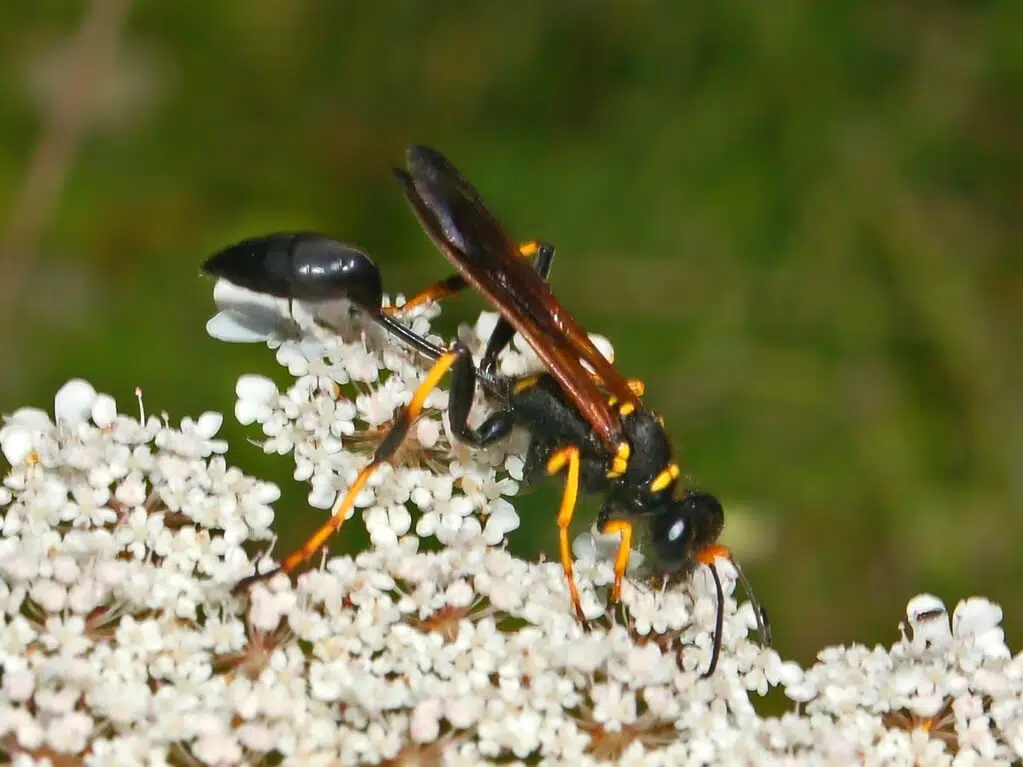
The yellow-legged mud dauber wasp is found in a variety of habitats from homes to water edges to longleaf pines. They grow to 28mm with a black petiole, which is half the length of the abdomen. Some in the desert areas have a yellow petiole.
They have a black abdomen with yellow markings on the thorax. They are the only species with yellow markings on the legs in the United States.
5. Red Cone Gall Wasp
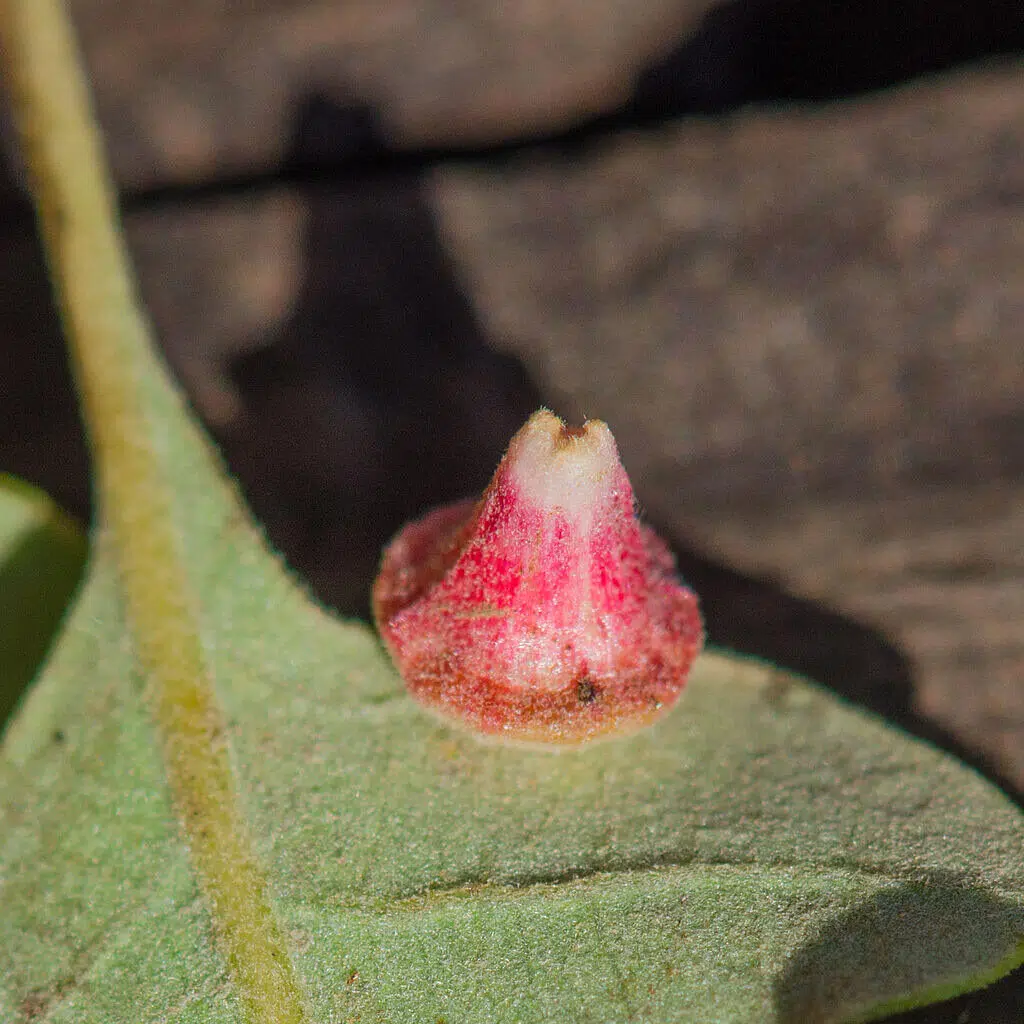
Red cone gall wasps (Andricus Kingi) create cone-shaped galls on the upper and lower leaf surfaces of white oaks. They are summer generation galls, that only contain female wasps. The galls range from cream to red, sometimes a combination of the two.
Galls in the spring are male and female and tend to form on the perimeter of the white oak leaf.
6. Guinea Paper Wasp
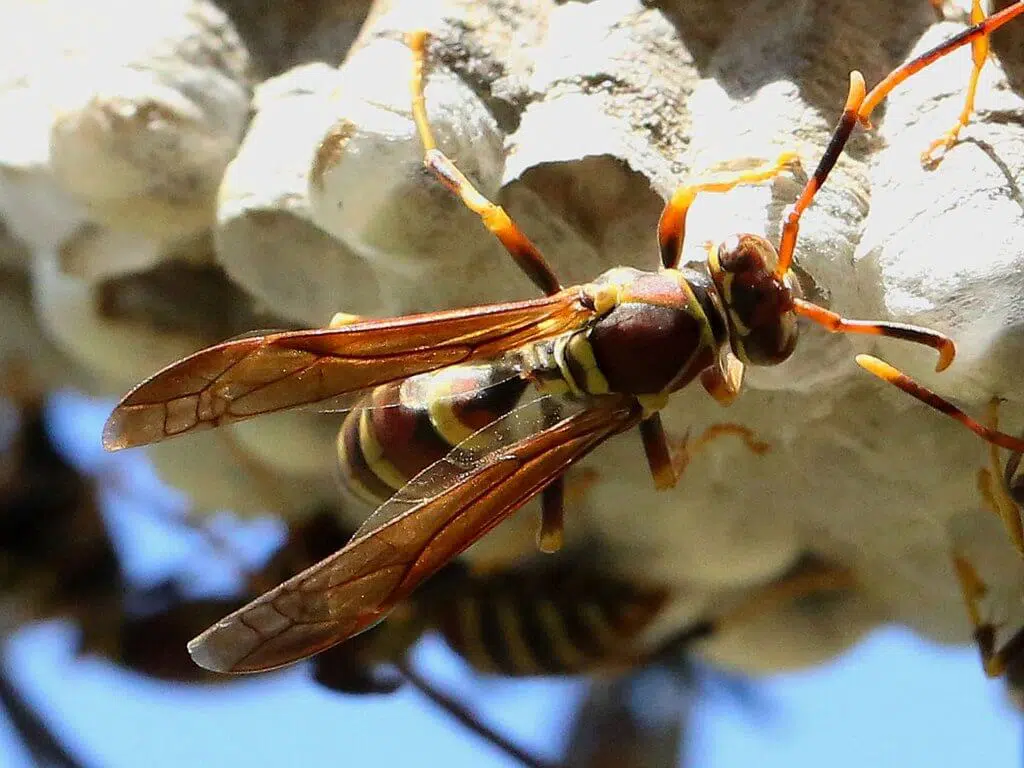
Guinea paper wasps (Polistes Exclamans) are social wasps and are common in California. Queens lay all the eggs in the colony, living in small and open combed nests. There are two types of this wasp, depending on their location.
Typical are found in the southeastern United States, while the variable is the one you will encounter in California. These are red to brown colored wasps with black wings. There are ivory to white-colored markings throughout the body.
7. Spined Turban Gall Wasp
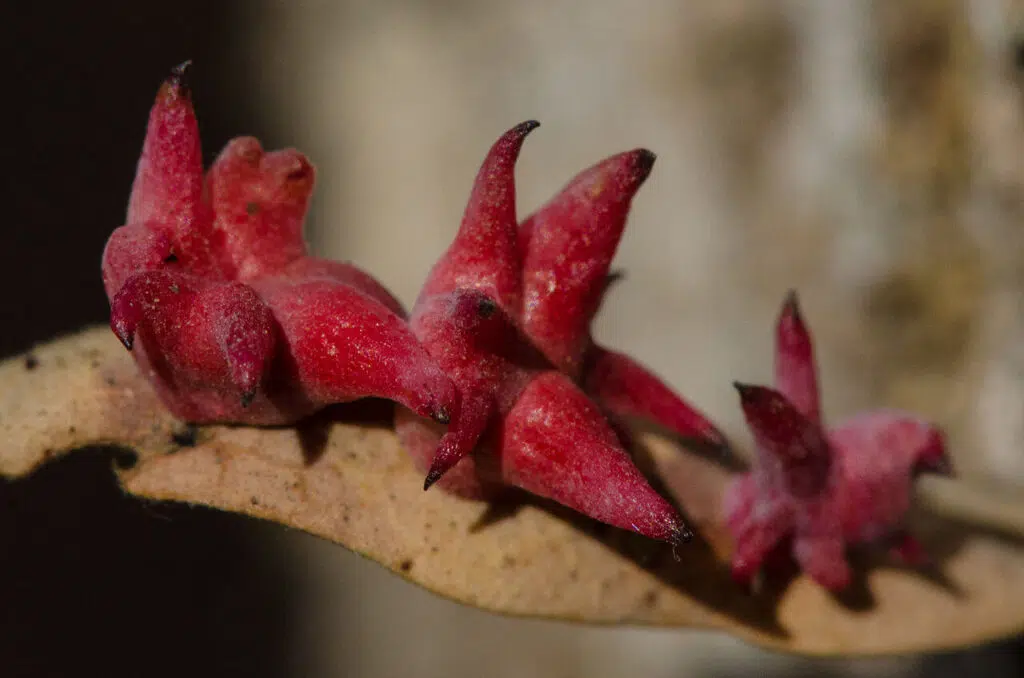
The spined turban gall wasp (Cynips Douglasii) creates uniquely shaped galls on oak trees, especially Valley Oaks.
Their galls vary from pink to white or even purple and look similar to a large anemone on a reef in the ocean. Each gall contains two chambers, the larval chamber, and an empty chamber, which remains a mystery.
8. Live Oak Apple Gall Wasp
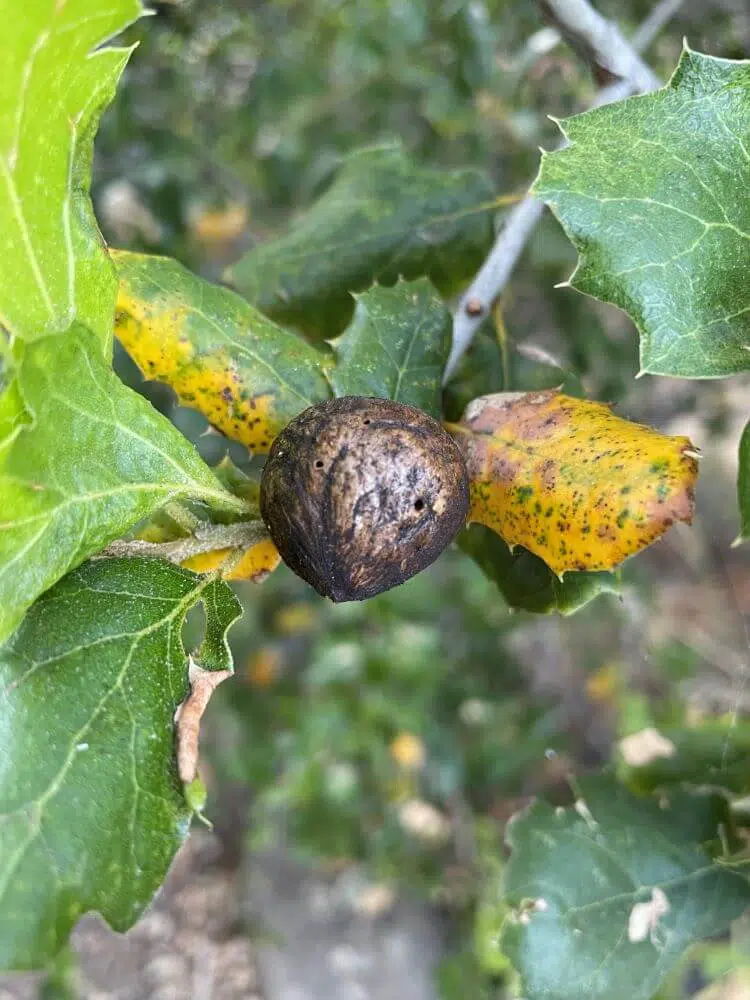
The live oak apple gall wasp (Amphibolips Quercuspomiformis) creates galls on oak trees, which vary based on the time of year. The summer unisexual generation all forms on stems during the summer months, while the bisexual generation galls forms on leaves in the springtime.
The galls contain the wasp larvae, which get nourishment from the gall until they are adult size and break free.
9. Golden Paper Wasp
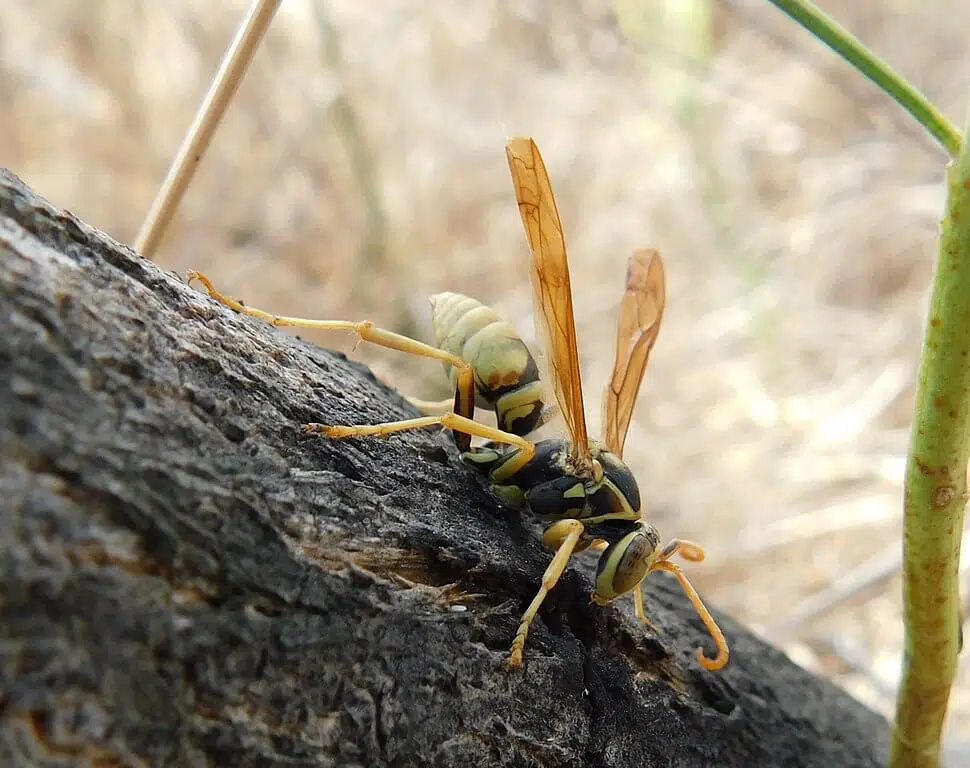
The golden paper wasp (Polistes Aurifer) has different color patterns based on its location. The wasps you find in California have almost yellow metasoma with restricted black. This is a social wasp, which creates nests in sheltered locations, including near man-made structures.
In California, the adults are more common from January to November.
10. Beaked Twig Gall Wasp
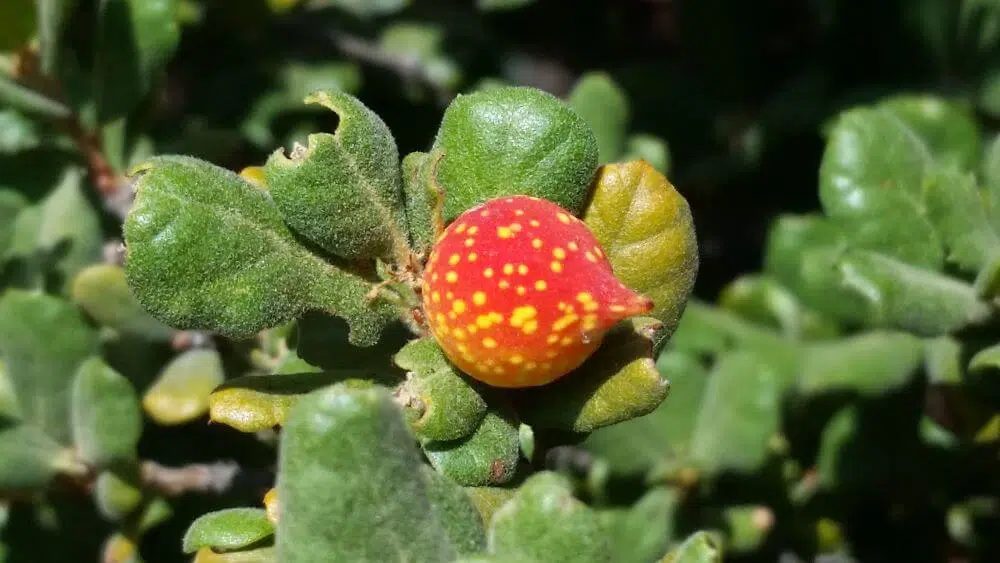
The beaked twig gall wasp (Burnettweldia Plumbella) makes galls in the late spring and summer on a variety of oaks. The galls can be up to 15mm in diameter and are usually green or red with yellow dots. These galls can be found on many different oak species, usually on younger stems.
11. Pumpkin Gall Wasp
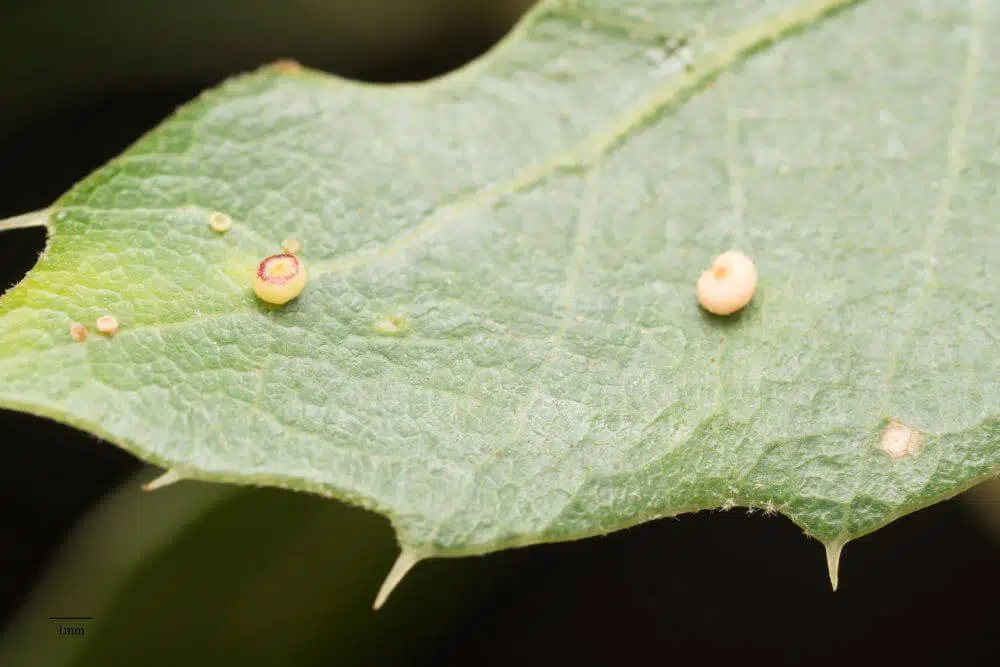
This cynipid wasp (Dryocosmus Minusculus) creates a tiny 1mm wide gall on the upper surface of black oak tree leaves. The galls are pumpkin-shaped, which has given this wasp its name. These are tiny wasps that deposit their eggs inside the leaves.
Their egg deposit produces a substance that gets the oak to develop a gall material, which provides the larva with nutrition and protection until it matures. The pumpkin gall wasp creates galls on coast live oaks, interior live oaks, and California black oaks.
12. American Sand Wasp
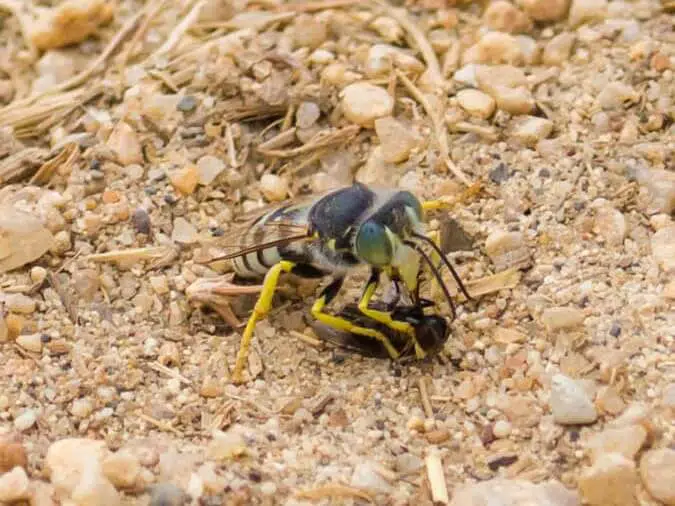
The American sand wasp (Bembix Americana) is a medium-sized wasp, growing to 20mm in body length. They are mostly black with white markings in the abdomen. The face and top of the head have short white hair.
The upper lip is triangular and long with large eyes on the side of the head and three small eyes in a triangle on top of the head. The two large eyes are green. They have a black thorax with no white markings.
They have a black abdomen with ten spots, with each pair of spots forming a band, which is interrupted in the center. The wings are clear with pale brown veins. Their legs are mostly yellow.
13. Great Golden Digger Wasp
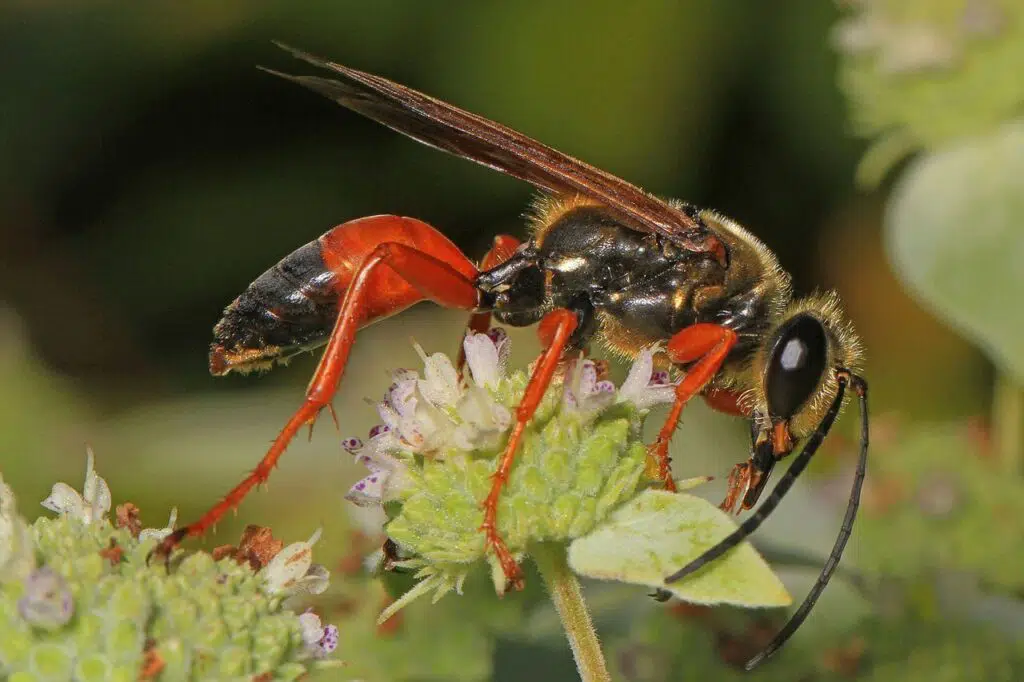
The great golden digger wasp (Sphex Ichneumoneus) is a non-aggressive wasp that will mind its own business, as long as you leave them alone. They are often observed sipping on the nectar of flowers during the summertime.
Females dig into loose soil to create tunnels, which she covers while attracting small insects. She stings and paralyzes the insects and then returns them to her tunnels. If she manages to get the insect back to the nest, she places it in the tunnel, laying an egg on the insect and closing the tunnel up again.
These wasps are orange and black with interesting behaviors.
14. Disc Gall Wasp
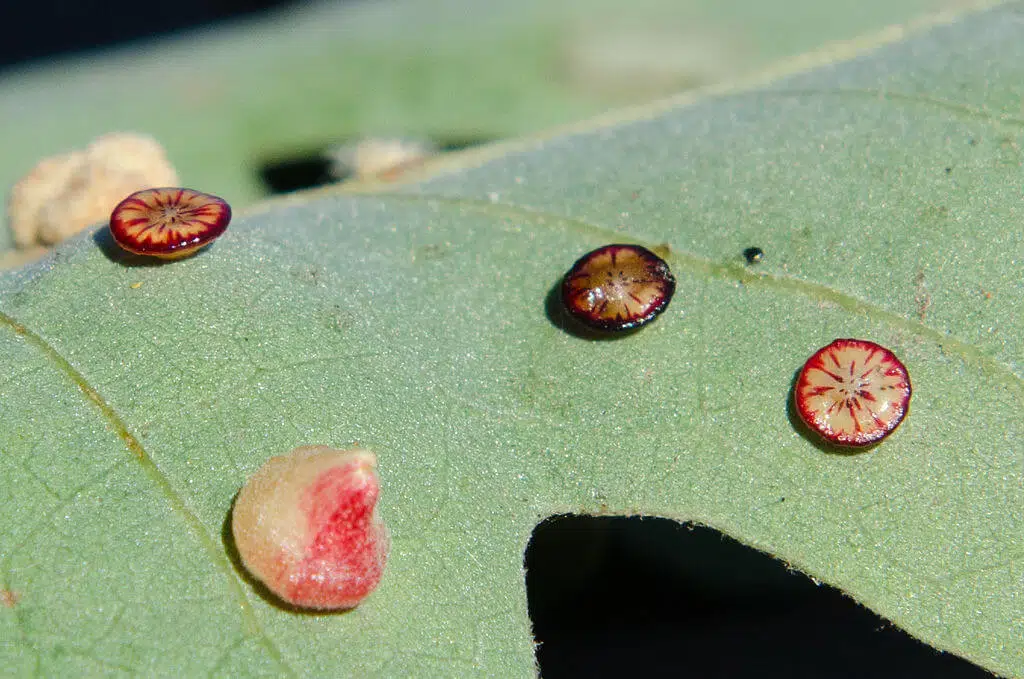
This gall wasp (Andricus Parmula) can induce flat and disc-shaped galls on both sides of the leaves of white oak trees. Their glossy and disc-shaped galls can be up to 3mm in diameter with a narrow base and smooth edge.
The wasps are not aggressive and mature inside the gall, emerging as adults and begin mating almost right away.
15. Thisbe’s Tarantula-hawk Wasp
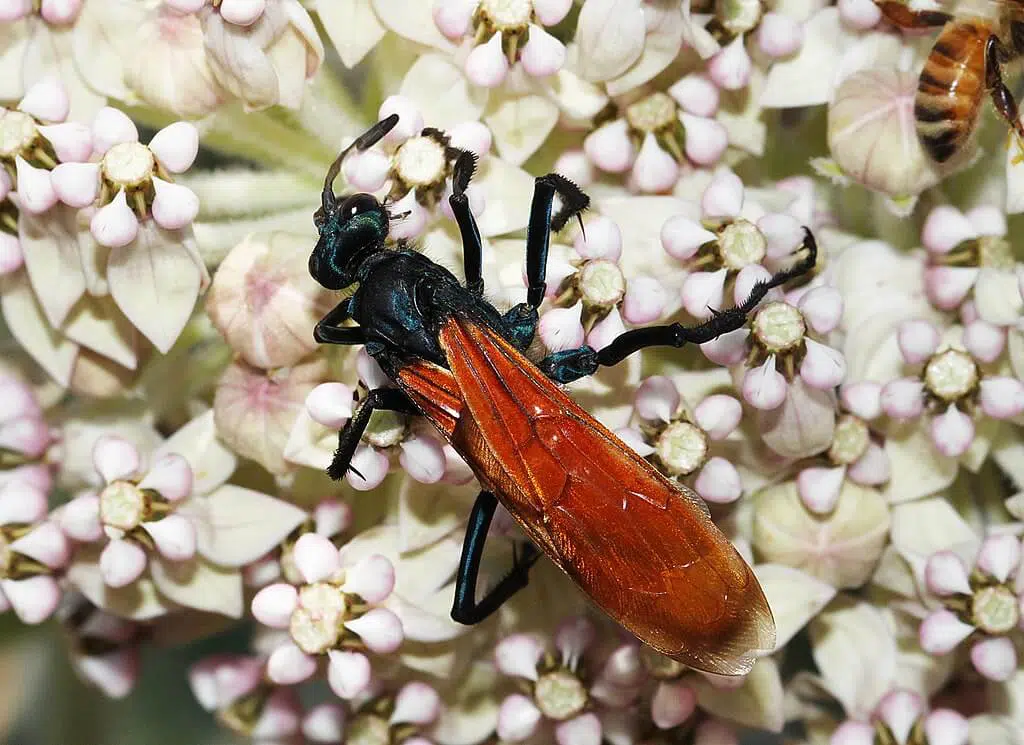
The Thisbe’s tarantula hawk wasp (Pepsis Thisbe) preys on tarantulas. They are a large parasitoid wasp that uses their sting to paralyze the tarantula and drag it back to their nest, as living food for their hatching larvae.
These wasps can grow to 5cm in length and are one of the largest wasps. They are blue/back in color with rusty-colored wings. They have hooked claws on their legs, helping them grab their prey.
The female has a long stinger of up to 7mm. It provides one of the most painful insect stings in the world. The good news is that they are not an aggressive species and seldom sting without being provoked.
16. Convoluted Gall Wasp
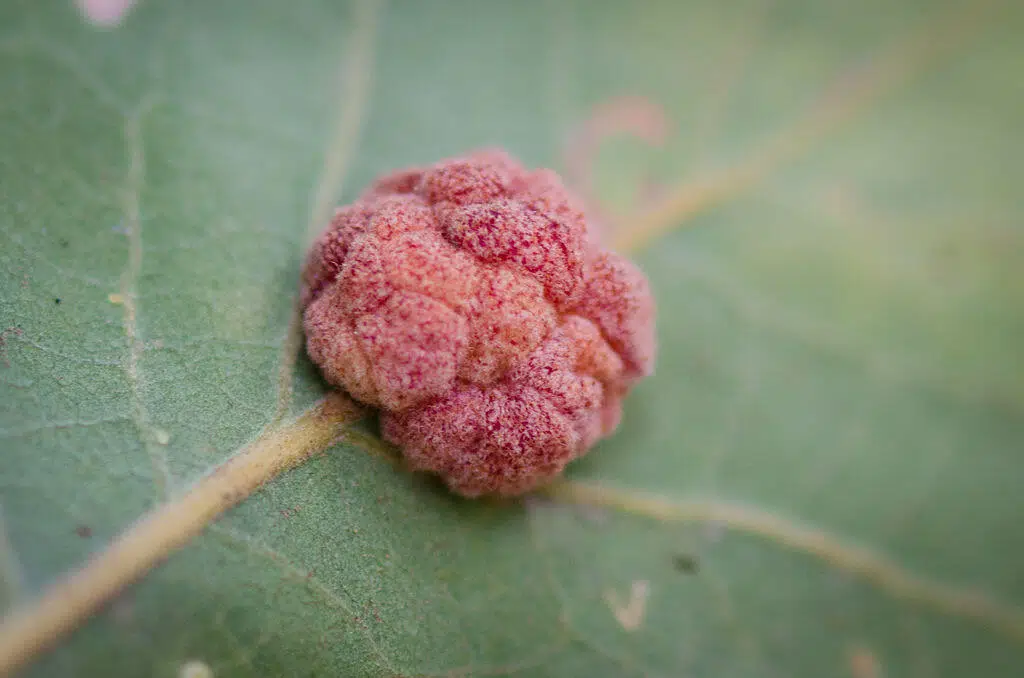
The convoluted gall wasp (Andricus Confertus) is one of the many gall wasps you can encounter in California. They are not aggressive and cause brain-looking clustering galls on the underside of the valley oak leaves. The clusters have fine hairs.
17. Gouty Stem Gall Wasp
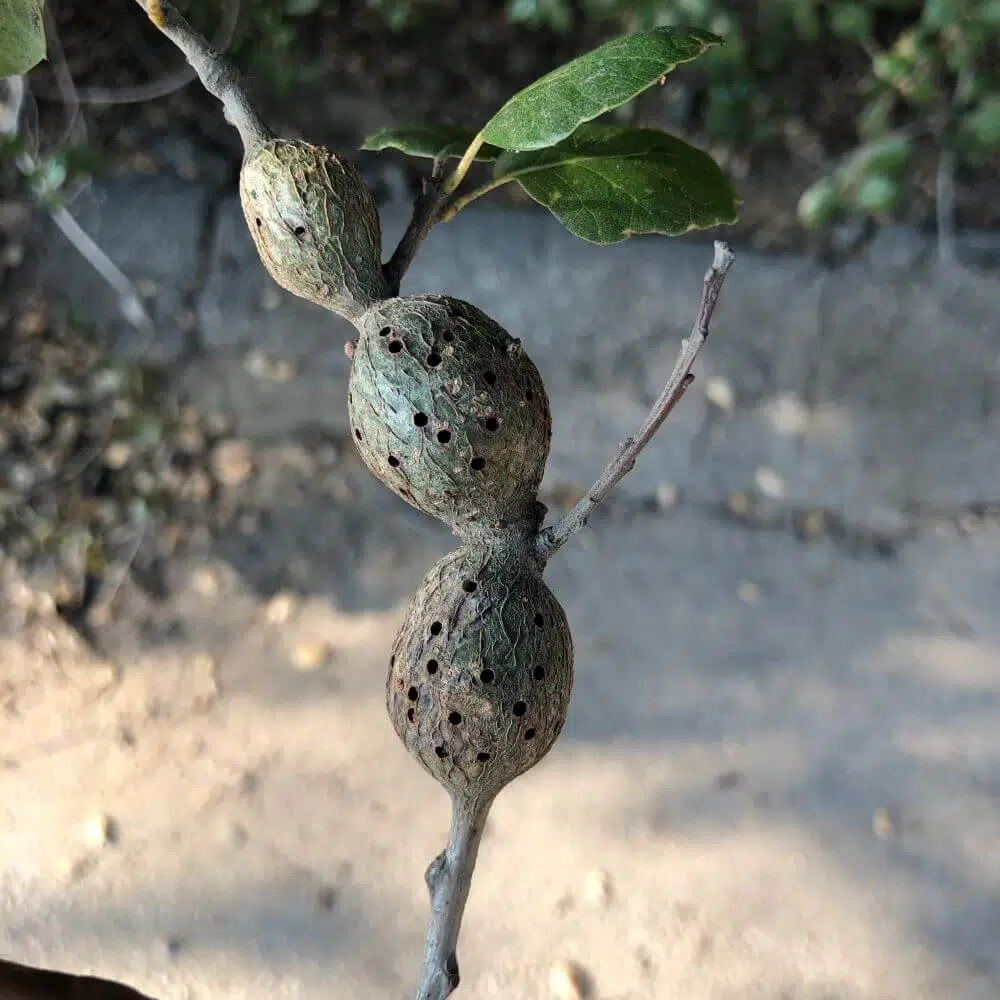
The gouty stern gall wasp (Callirhytis Quercussuttoni) creates woody stem galls on soak trees, specifically in the black oak group on the western coast of North America.
The galls contain female generations only. These females then lay their eggs in the leaf buds, which cause a blister gall on the leaf veins and petioles.
Male and female wasps emerge from the blister galls on the leaves.
18. Crystalline Gall Wasp
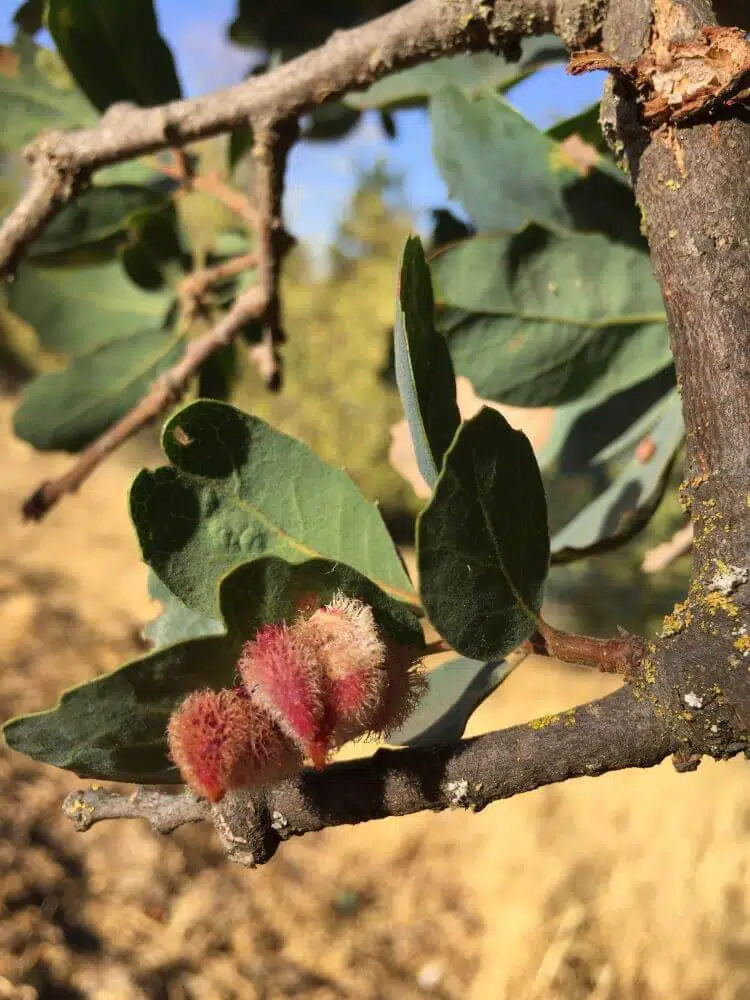
Gall wasps (Andricus Crystallinus) are often referred to as gall flies, belonging to the Cynipidae family. They create galls on trees, which nourish the larva as the wasp grows. These are small wasps, usually no more than 8mm in length.
The crystalline gall wasp creates pine cone calls with white hairs, which are found in scrub oak in chaparral. In summer and fall, the unisex generation galls can be seen on the underside of leaves of scrub and oaks. The galls appear in clubs, as one hairy mass on a leaf. In spring the bisexual generation galls can be seen, they are smaller and are individually placed.
19. Yellow Wig Gall Wasp
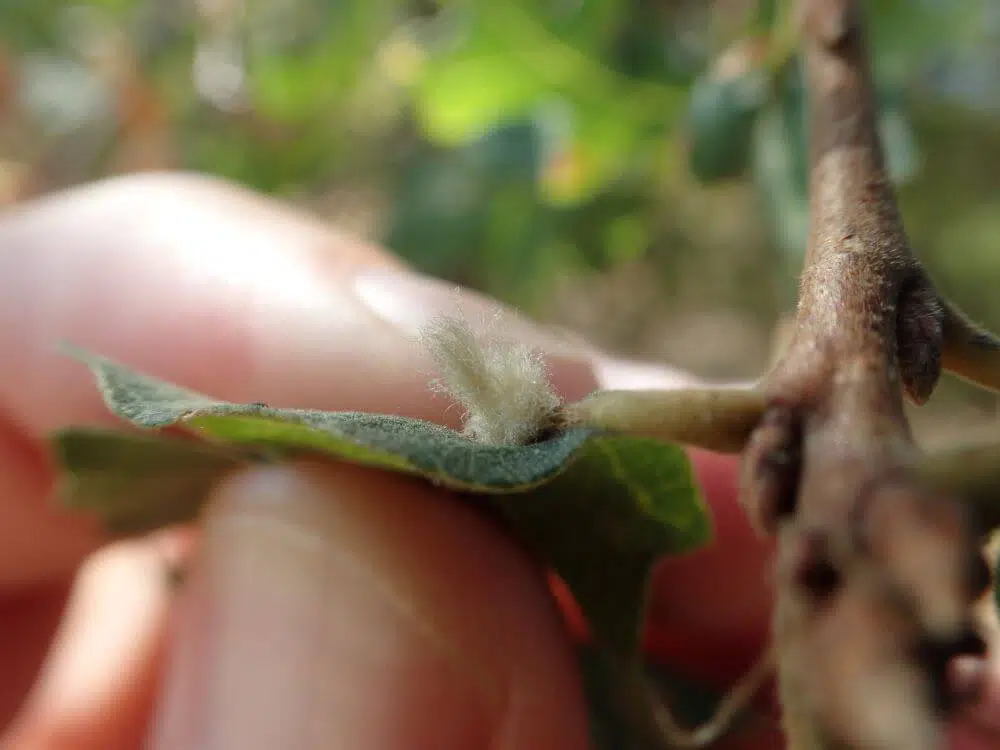
Andricus fullawayi are small cynipid wasps that cause small and oval galls on white oaks. These galls have dense straw yellow to fawn colored hairs. They are mostly seen in spring and early summer.
The galls occur on the ventral midrib of white oak leaves.
20. Toltec Scoliid Wasp
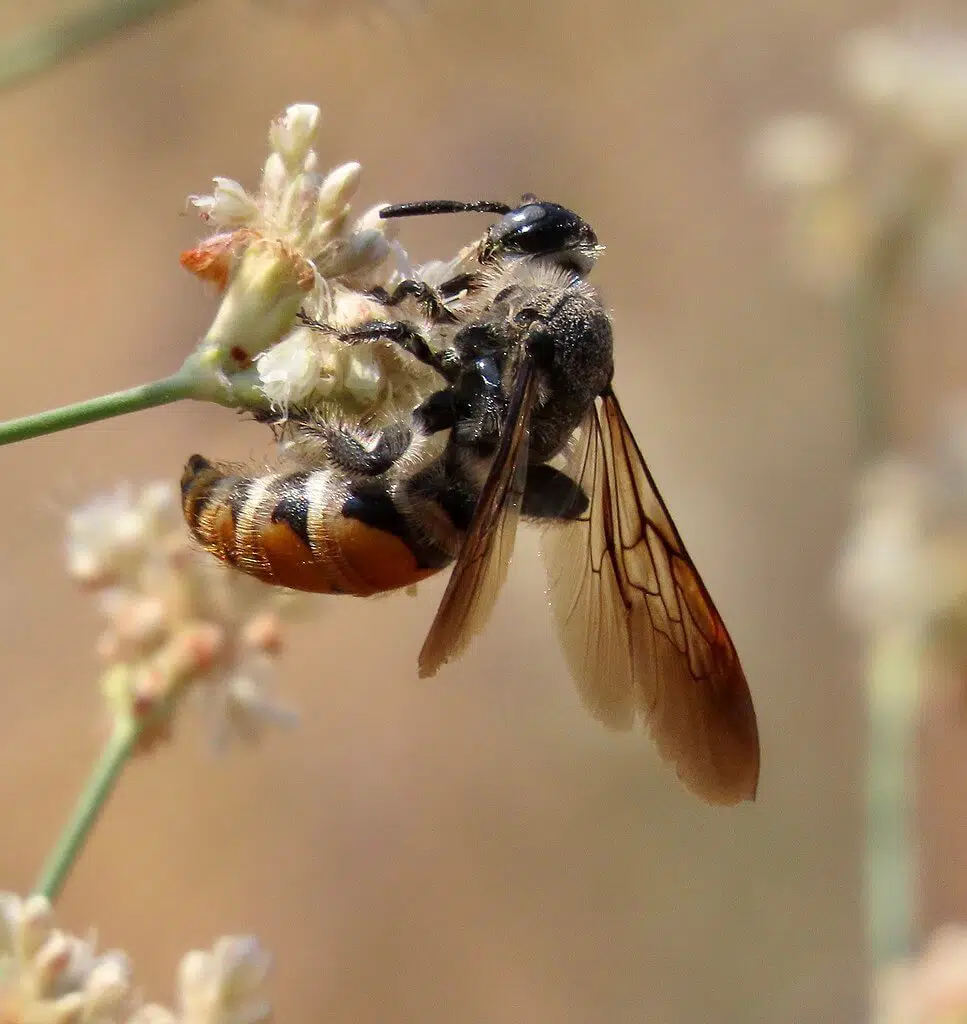
These are small wasps with females having orange markings on their abdomen. Males have four abdominal bands. They are common in California.
These are non-aggressive wasps that are often seen sipping on flowers’ nectar. They will not sting if they are not provoked, it is best to leave them alone to go about their day.
21. Saucer Gall Wasp
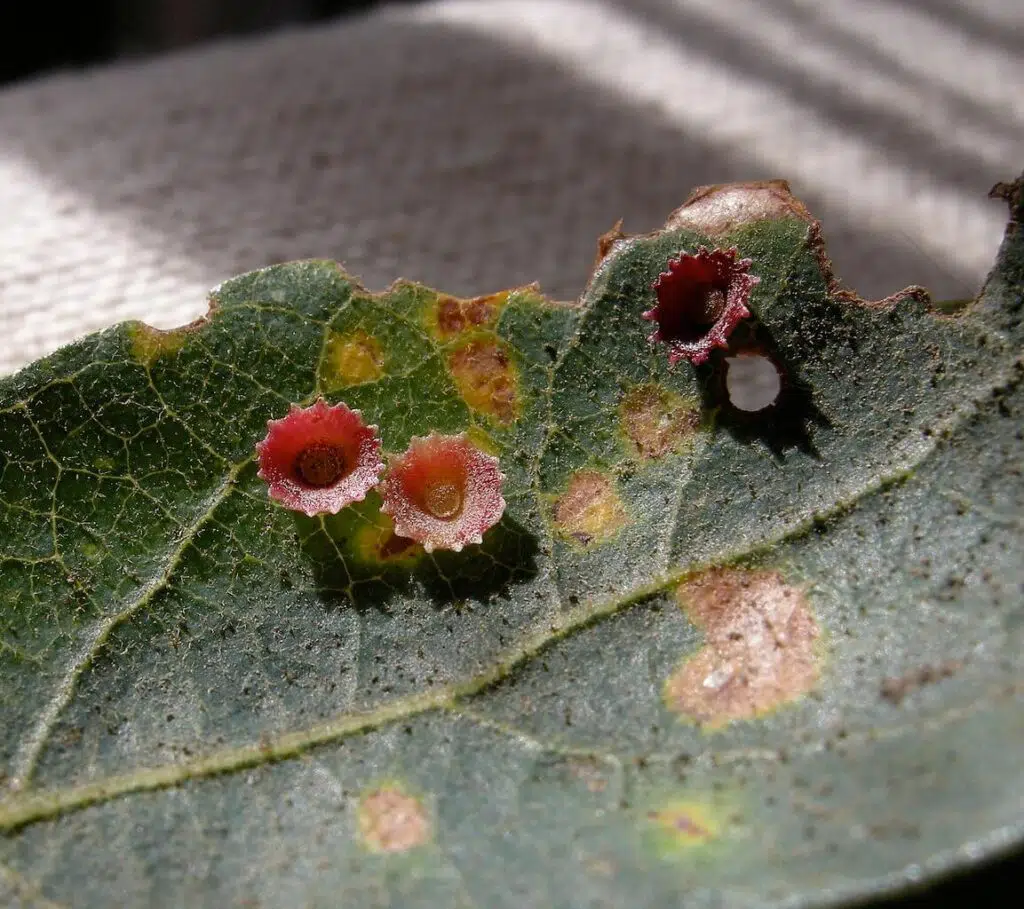
The saucer gall wasp (Andricus Gigas) is a small wasp that creates 3mm to 4mm wide galls. The larvae of the unisex summer generation develop in the gall on the upper surface of leaves, while the bisexual spring generation is in conical and tan galls.
The galls are small dish-shaped and are often seen on white oaks. They are coated in fine hairs and can vary from yellow to red.
22. Spiny Leaf Gall Wasp
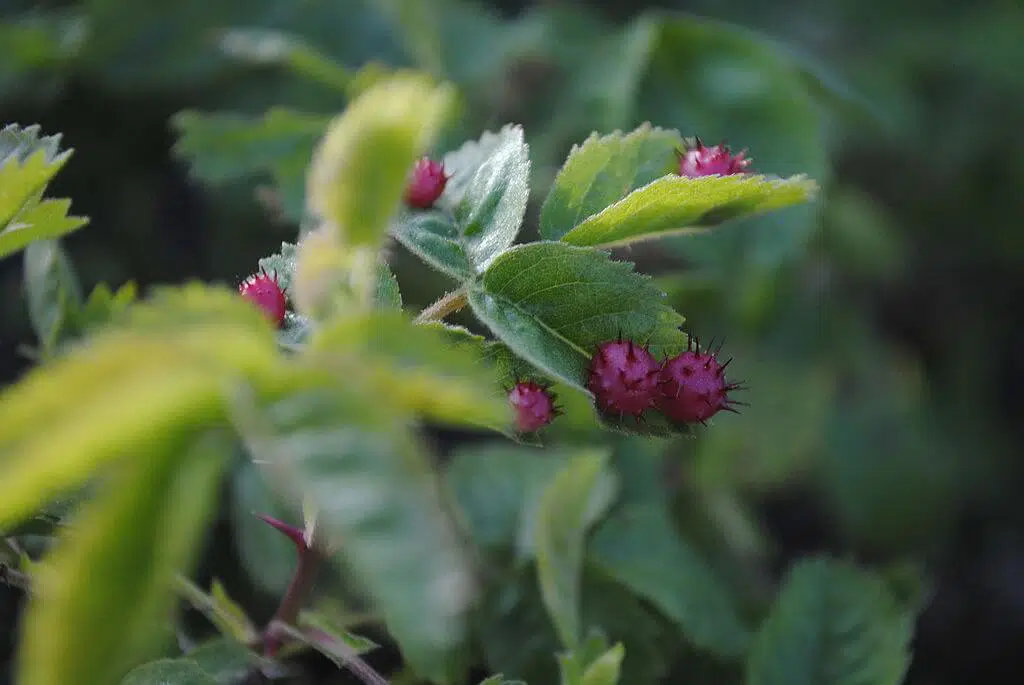
Spiny leaf gall wasps (Diplolepis Polita) are small black and brown wasps with light brown, almost transparent wings. They grow to 3.5mm in length. They induce galls on rose plants.
They are small in appearance and easily distinguished on the dorsal side of the rose leaf.
23. Honeydew Gall Wasp
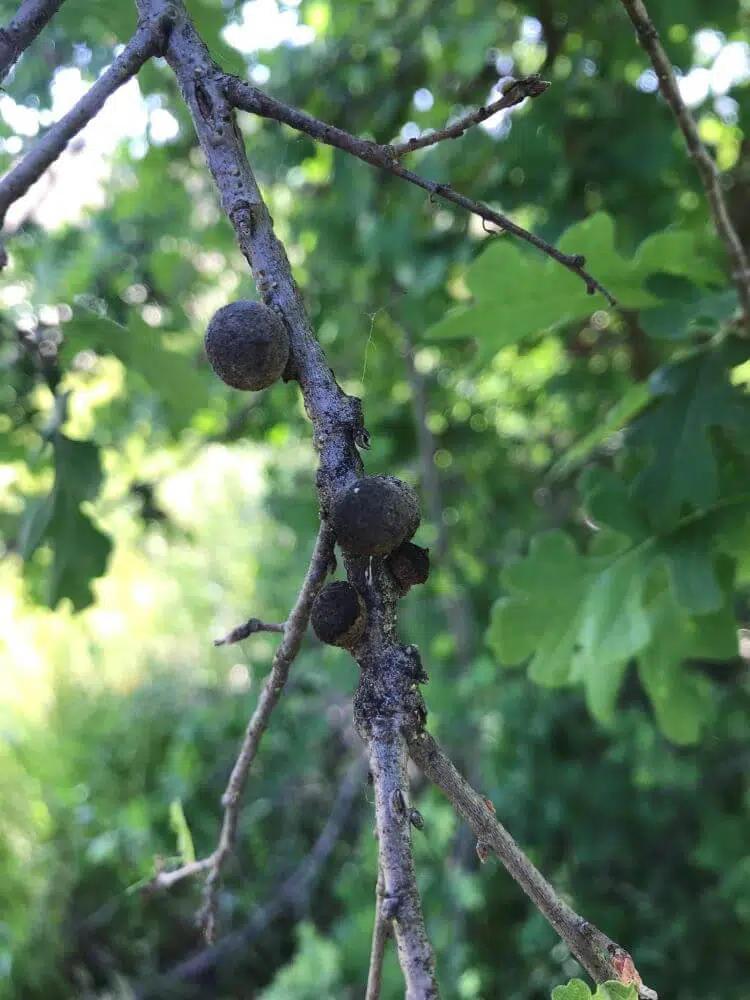
The honeydew gall wasp (Disholcaspis Eldoradensis) can grow to 8mm in body length. They have an oval and shiny abdomen and are colored mostly black with brown abdomen and transparent to light brown wings.
These wasps inject an egg into the plant, which forms a gall, The gall is a host and protective space for larvae to grow, breaking out once they reach adult size.
24. Urchin Gall Wasp
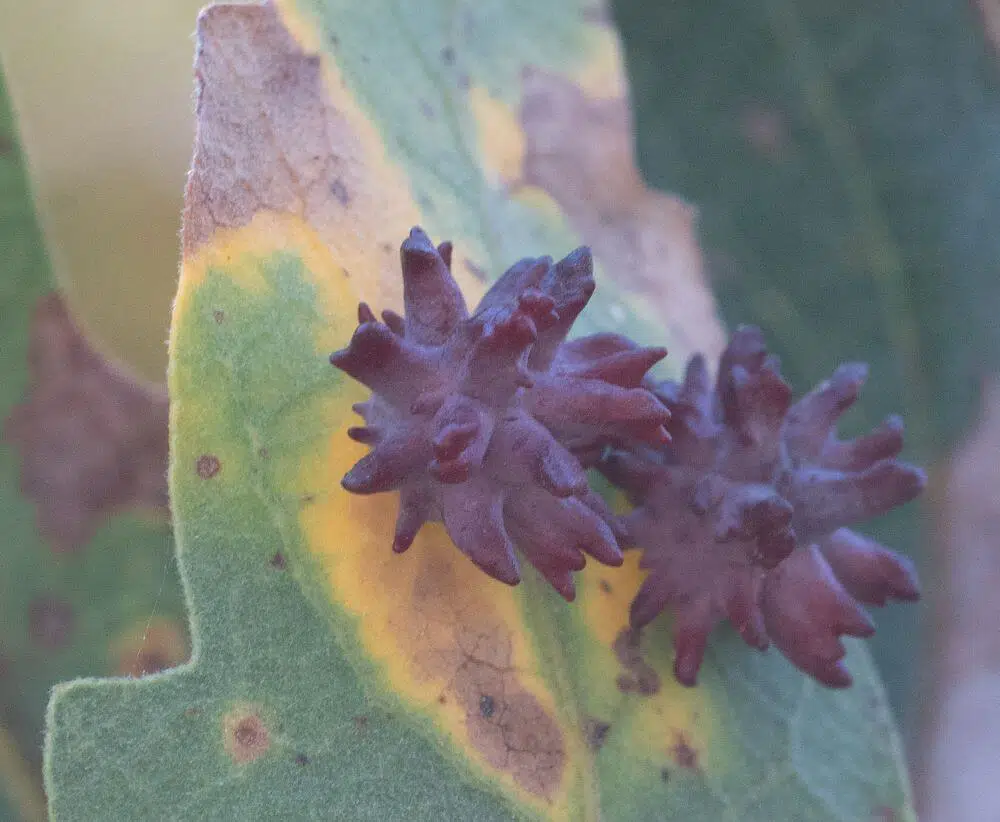
The urchin gall wasp (Cynips Quercusechinus) belongs to the Cynipidae family and induces a gall that looks like sea anemones on the leaves of oak trees. The galls can be up to 10mm in diameter and fall with leaves in the fall. The larvae emerge in the springtime as adults.
This species of gall wasp was first described in 1870 in California. The galls are red to pink in color, usually found on blue and scrub oaks. Bisexual generations develop in the galls on buds, while summer galls appear as swollen buds and are harder to find.
25. Beaked Spindle Gall Wasp
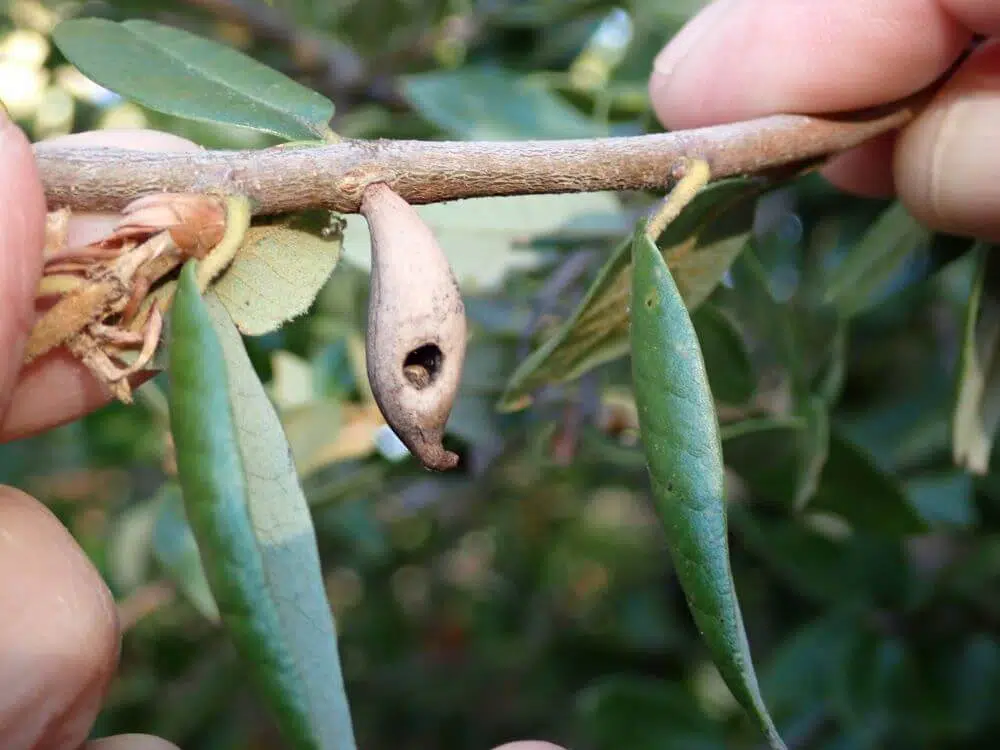
The beaked spindle gall wasp (Heteroecus Pacificus) belongs to the Cynipidae family inducing galls on canyon live oak and huckleberry oak in California. These wasps induce two generations per year, one is males and females, while the other is females only.
During the summer months, a larva of the unisexual generation induces an elongated and spindle-shaped gall on the stem. These galls are pale yellow or green to red. In spring the generation pupates into adult females which oviposit on the nutrient-rich new leaves, which creates longitudinal and compressed galls.
The bisexual spring galls develop faster and soon yield mature larvae of males and females, which emerge in spring.
26. Two-horned Gall Wasp
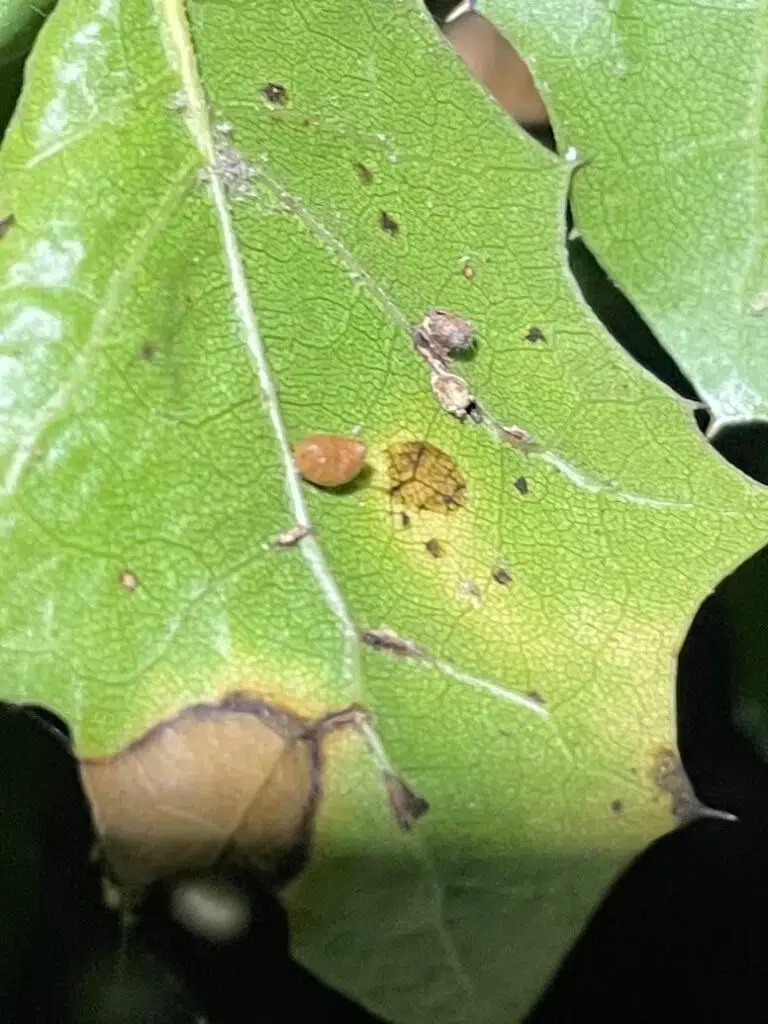
Two horned gall wasps (Dryocosmus Dubiosus) are tiny wasps that induce a brown seedlike gall on evergreen oak trees. They have high populations, which cause extensive leaf scorching and cause leaves to drop prematurely.
Each wasp larva in the second generation feeds inside the brown seedlike gall, which can grow to more than an inch in length. The galls can be seen on the underside of coast live oak and on the inside of live oak leaves, usually seen on the leaf vein.
The first generation of wasp larvae develops in late winter to early spring from eggs that were laid inside the oak catkins. The affected flower parts turn to red or brown galls, which feed the larva inside. The second-generation larvae forms galls once they hatch from their eggs, which were laid in the vein of the leaves.
The wasps stay in the gall over winter, dropping from the leaf. The two-horned gall wasp only kills a portion of the leaf, with leaf margins discoloring and dying. Each leaf with a gall will remain green, with discolored leaves being seen on the same twig.
While the two-horned gall wasp can create undesirable-looking galls on oaks, they do not threaten the health of the tree. There are no control measures or any specific recommended measures if you have these galls on your oaks.
27. Alaska Yellowjacket
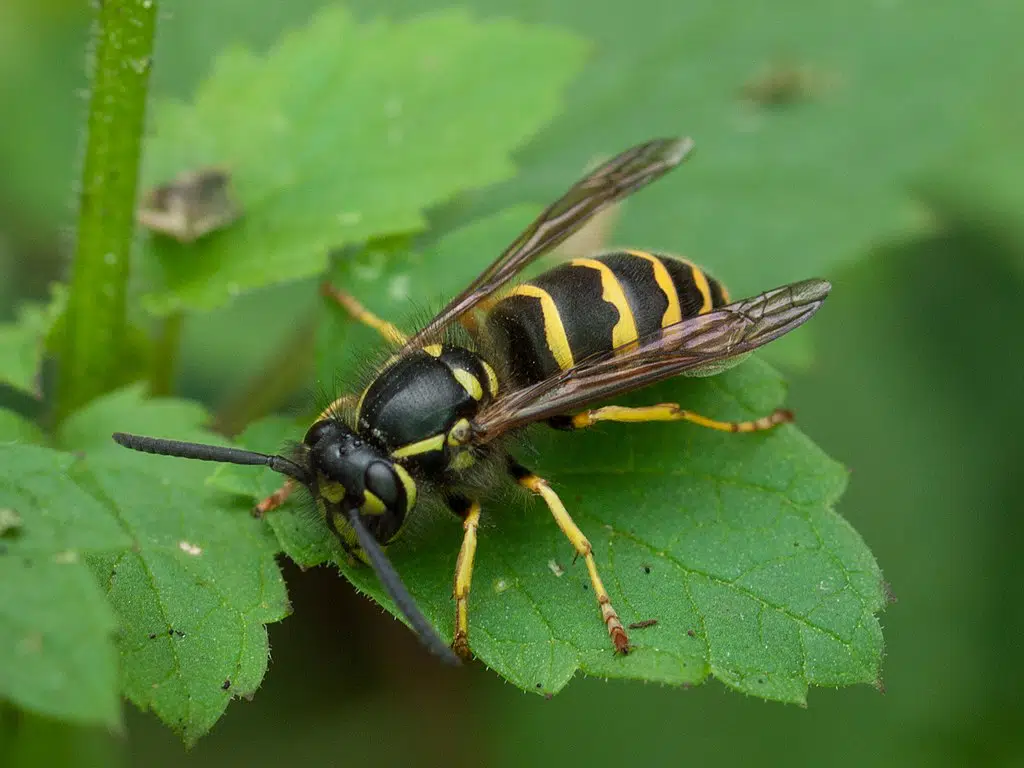
The Alaska yellow jacket (Vespula Alascensis) is a North American eusocial wasp which is a black and yellow wasp that is commonly seen in aerial nests, which are created in decaying vegetation. They are not often encountered by humans, as they prefer to inhabit forests.
This is a very aggressive species and they will sting repeatedly if disturbed or their nests are threatened. These are relatively small wasps growing to 15mm in length.
28. Western Paper Wasp
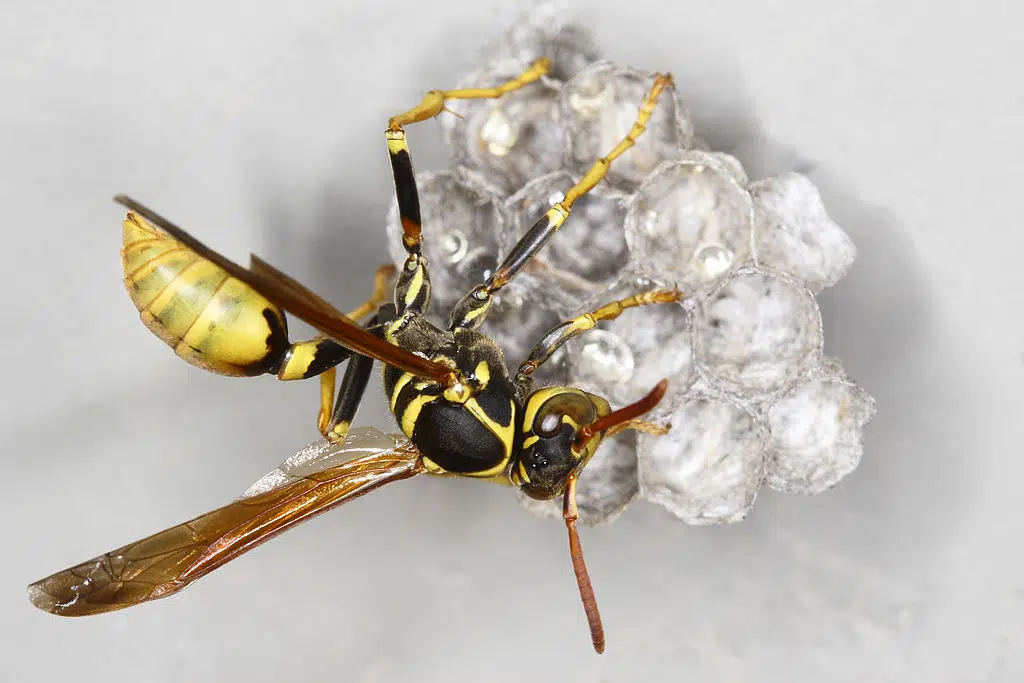
This is a social paper wasp (Mischocyttarus Flavitarsis) that is common in western North America. Their nests are found in forests, usually close to rivers. They are also common close to humans, building nests under roof eaves.
They do not usually sting but ram into the threat. Their colony cycle starts just before May, lasting through to October. Queens then seek hibernation for the winter months.
Males perch close to female hibernation sites, climbing their territory by rubbing brushes on the border of the side, which leaves a chemical. Their diet comprises nectar and anthropods.
These are slender wasps that trail their hind legs behind them. They are brown. The nests can hang from a 3mm pedicle and are round under the stem.
Their nests are usually found in riparian forests, deciduous and hard evergreens, and conifers. They are also known to build their nests in wall voids and under eaves.
29. Milde’s Tarantula-hawk Wasp
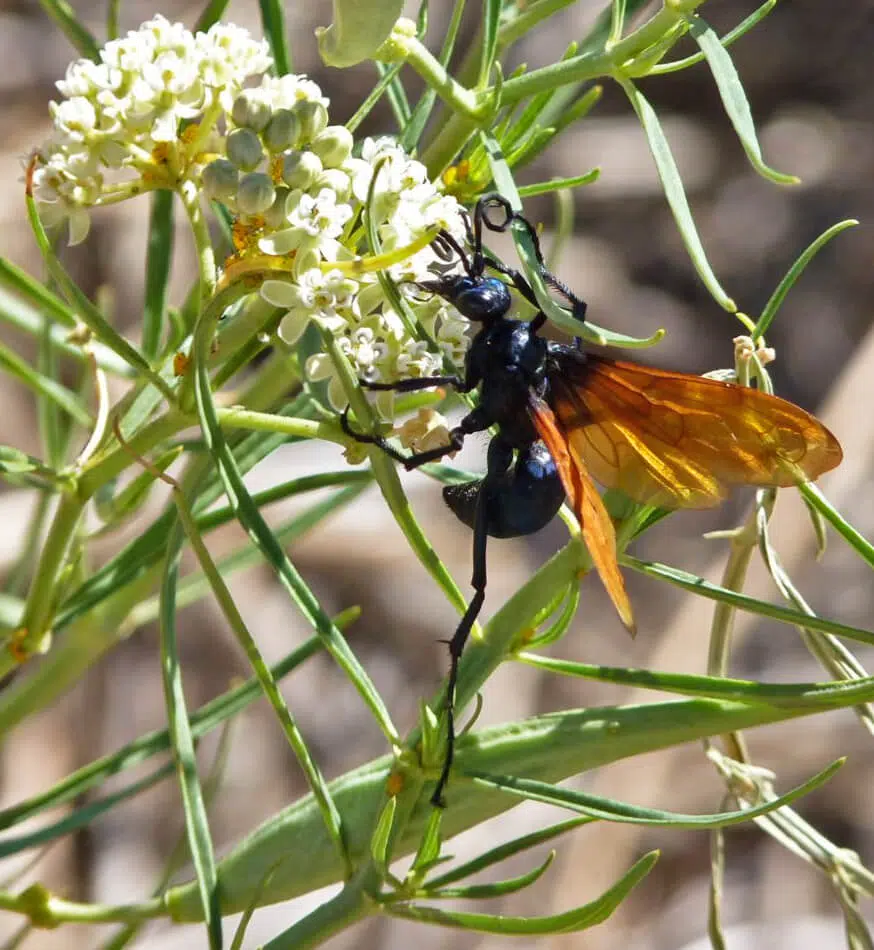
The Milde’s tarantula hawk wasp (Pepsis Mildei) preys on tarantulas. This is one of the largest parasitoid wasps, which use their sting to paralyze their prey and drag it to their nest as food for their egg.
These large wasps can be up to two inches (five centimeters) in length, making them one of the largest wasps with blue to black bodies and rusty colored wings. They have claws on their legs, which helps them hold onto their victim.
The female can have a stinger that is up to 7mm in length, which is powerful enough to paralyze the large and hairy tarantula. It is believed to be one of the most painful stings.
Females sting the tarantula between the legs, which immediately paralyzes it. This enables her to drag the spider to her prepared burrow. She lays a single egg on the spider’s abdomen and covers over the burrow.
This is a relatively docile species and a rare sting unless provoked. Their sting is intense pain, lasting around five minutes.
30. Steel-blue Cricket-hunter Wasp
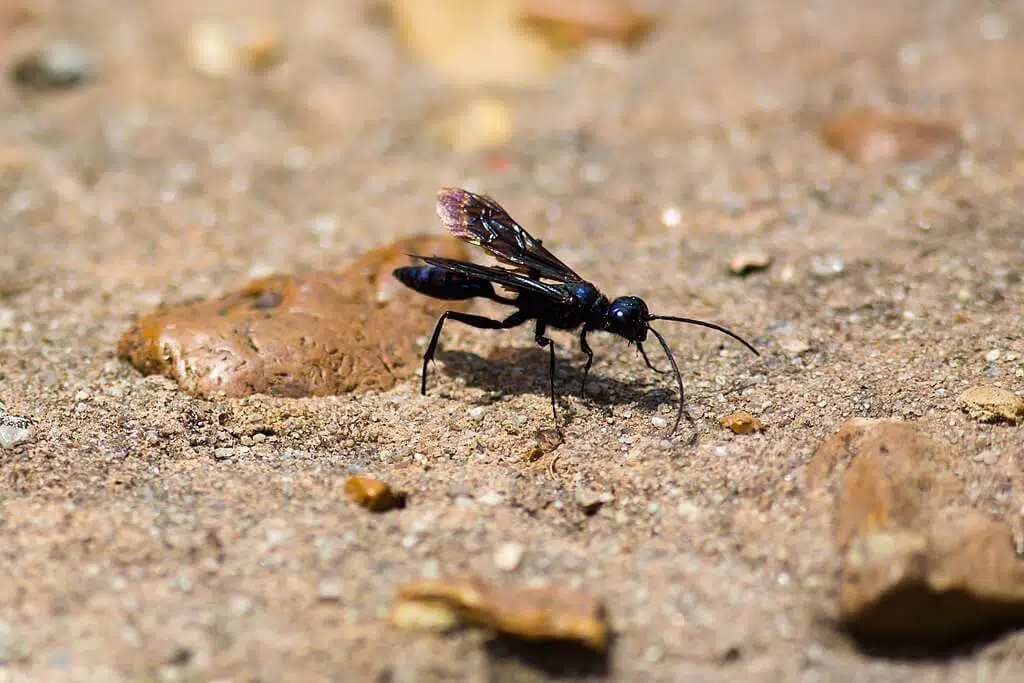
Steel-blue cricket hunter wasps (Chlorion Aerarium) are blue wasps, which are shiny and have a thin waist. Their dark wings are similar to an oil slick.
The female is known to hunt crickets, which they paralyze and take back to her nest to feed her larva, once the eggs hatch.
Each cell of the underground nest contains a single fertilized egg and up to ten nymphs or adult crickets. Sometimes they use grasshoppers.
The adult’s diet is mostly flower nectar, never far from where crickets live. They are often encountered in meadows, overgrown lots, coastal areas, and backyards.
They are not an aggressive species.
Further Reading: